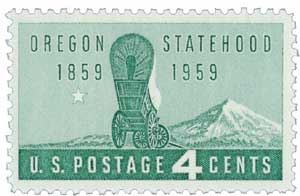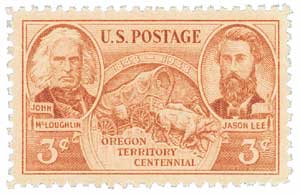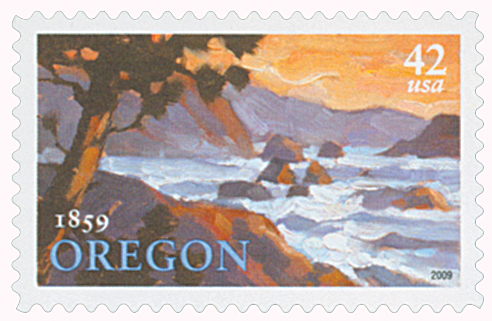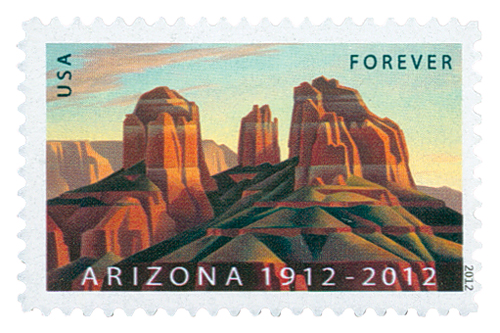
# 3563 - 2002 34c Greetings From America: Arizona
Arizona
34¢ Greetings From America
City: New York, NY
Quantity: 200,000,000
Printed by: American Packaging Corp for Sennett Security Products
Printing Method: Photogravure
Perforations: Serpentine Die Cut 10.75
Quantity: 200,000,000
Oregon And Arizona Become U.S. States

On February 14, 1859, Oregon was admitted to the Union. And 53 years later, so was Arizona. Let’s begin with Oregon’s road to statehood.
There was a large population of American Indians living in Oregon when the first Europeans arrived. Spanish sailors traveling from the Philippines to Mexico were probably the first white people to spot the coast of Oregon.

In the early 1800s, the Oregon region was defined as stretching from Alaska, which was controlled by Russia, to California, which was ruled by Spain. Oregon’s eastern boundary extended all the way to the Rocky Mountains. Russia, Spain, Great Britain, and the United States all made claims on this area. In 1819, Spain signed a treaty giving up its claim to territory north of latitude 42º, which is modern Oregon’s southern boundary. Russia relinquished its claims south of 54º 40’. However, the U.S. and Britain could not agree on a boundary, and signed an agreement by which citizens of both nations could settle in Oregon.

Methodist missionaries at Willamette Valley created the first permanent American settlement in Oregon in 1834. After this settlement was established, hundreds of Americans began pouring into the area every year, especially after the creation of the Oregon Trail. This put pressure on the U.S. and Britain to settle their boundary dispute. In 1844, James K. Polk ran for the U.S. presidency and based his campaign on the view that land south of 54º 40’ belonged to the U.S. The slogan “Fifty-Four Forty or Fight” became a big part of his campaign. Polk was elected President, and he signed a treaty with Great Britain fixing the 49th parallel as the main dividing line between the territories of the two nations in 1846.
Oregon settlers organized a provisional government in 1843 and became a territory five years later. In 1853, the Washington Territory was created, and Oregon received the boundaries it has today. The territory grew fast after the Donation Land Law of 1850 was passed. This law gave 320 acres of land to any U.S. citizen over 18 years old. With its population booming, Oregon was able to apply for statehood, which it received on February 14, 1859.

Now let’s travel south to Arizona, which was once home to the Anasazi – the ancestors of the Pueblo Indians. Stories of the Seven Cities of Cibola – said to contain great amounts of wealth – sent many Spanish explorers on futile quests into the region. A Franciscan priest, Marcos de Niza, was the first white person known to reach Arizona in 1539.
In 1752, the Spanish established the first white settlement at Tubac. When Mexico won its independence from Spain in 1821, Arizona became part of Mexico. The area changed hands again after the Mexican-American War, when most of Arizona became part of the U.S. Arizona settlers unsuccessfully attempted to become a distinct U.S. territory in the 1850s. Many settlers were from the South, and were sympathetic to the Confederacy when it was formed in 1861. When the Confederate government created the Confederate Territory of Arizona, it was largely a symbolic gesture.

U.S. Congress created the Arizona Territory in 1863, with roughly the same boundaries as the modern state. Despite the dangers presented by hostile Indians, Arizona grew in the years following the war. The territory’s economic growth was fueled by discoveries of gold and silver. Ingenuity also aided Arizona. Farmers began irrigating their fields as early as 1867. During the 1870s and ’80s, copper mines were developed. On September 30, 1877, the Southern Pacific Railroad connected Arizona to California, further enhancing the territory’s growth.

Around 1890, well-organized groups began to lobby Congress in an effort to achieve statehood. However, Congress refused to act for 20 years. In 1910, Arizona was allowed to create a state constitution and apply for statehood. This was done, but President William Howard Taft vetoed the bill that would have granted statehood. Taft was concerned the state constitution allowed for recall – a process through which voters could remove judges from office. Once this clause was taken out of the constitution, statehood was approved. Arizona finally achieved statehood on February 14, 1912. Soon after, the people amended their constitution to allow recall of judges.
Arizona
34¢ Greetings From America
City: New York, NY
Quantity: 200,000,000
Printed by: American Packaging Corp for Sennett Security Products
Printing Method: Photogravure
Perforations: Serpentine Die Cut 10.75
Quantity: 200,000,000
Oregon And Arizona Become U.S. States

On February 14, 1859, Oregon was admitted to the Union. And 53 years later, so was Arizona. Let’s begin with Oregon’s road to statehood.
There was a large population of American Indians living in Oregon when the first Europeans arrived. Spanish sailors traveling from the Philippines to Mexico were probably the first white people to spot the coast of Oregon.

In the early 1800s, the Oregon region was defined as stretching from Alaska, which was controlled by Russia, to California, which was ruled by Spain. Oregon’s eastern boundary extended all the way to the Rocky Mountains. Russia, Spain, Great Britain, and the United States all made claims on this area. In 1819, Spain signed a treaty giving up its claim to territory north of latitude 42º, which is modern Oregon’s southern boundary. Russia relinquished its claims south of 54º 40’. However, the U.S. and Britain could not agree on a boundary, and signed an agreement by which citizens of both nations could settle in Oregon.

Methodist missionaries at Willamette Valley created the first permanent American settlement in Oregon in 1834. After this settlement was established, hundreds of Americans began pouring into the area every year, especially after the creation of the Oregon Trail. This put pressure on the U.S. and Britain to settle their boundary dispute. In 1844, James K. Polk ran for the U.S. presidency and based his campaign on the view that land south of 54º 40’ belonged to the U.S. The slogan “Fifty-Four Forty or Fight” became a big part of his campaign. Polk was elected President, and he signed a treaty with Great Britain fixing the 49th parallel as the main dividing line between the territories of the two nations in 1846.
Oregon settlers organized a provisional government in 1843 and became a territory five years later. In 1853, the Washington Territory was created, and Oregon received the boundaries it has today. The territory grew fast after the Donation Land Law of 1850 was passed. This law gave 320 acres of land to any U.S. citizen over 18 years old. With its population booming, Oregon was able to apply for statehood, which it received on February 14, 1859.

Now let’s travel south to Arizona, which was once home to the Anasazi – the ancestors of the Pueblo Indians. Stories of the Seven Cities of Cibola – said to contain great amounts of wealth – sent many Spanish explorers on futile quests into the region. A Franciscan priest, Marcos de Niza, was the first white person known to reach Arizona in 1539.
In 1752, the Spanish established the first white settlement at Tubac. When Mexico won its independence from Spain in 1821, Arizona became part of Mexico. The area changed hands again after the Mexican-American War, when most of Arizona became part of the U.S. Arizona settlers unsuccessfully attempted to become a distinct U.S. territory in the 1850s. Many settlers were from the South, and were sympathetic to the Confederacy when it was formed in 1861. When the Confederate government created the Confederate Territory of Arizona, it was largely a symbolic gesture.

U.S. Congress created the Arizona Territory in 1863, with roughly the same boundaries as the modern state. Despite the dangers presented by hostile Indians, Arizona grew in the years following the war. The territory’s economic growth was fueled by discoveries of gold and silver. Ingenuity also aided Arizona. Farmers began irrigating their fields as early as 1867. During the 1870s and ’80s, copper mines were developed. On September 30, 1877, the Southern Pacific Railroad connected Arizona to California, further enhancing the territory’s growth.

Around 1890, well-organized groups began to lobby Congress in an effort to achieve statehood. However, Congress refused to act for 20 years. In 1910, Arizona was allowed to create a state constitution and apply for statehood. This was done, but President William Howard Taft vetoed the bill that would have granted statehood. Taft was concerned the state constitution allowed for recall – a process through which voters could remove judges from office. Once this clause was taken out of the constitution, statehood was approved. Arizona finally achieved statehood on February 14, 1912. Soon after, the people amended their constitution to allow recall of judges.














